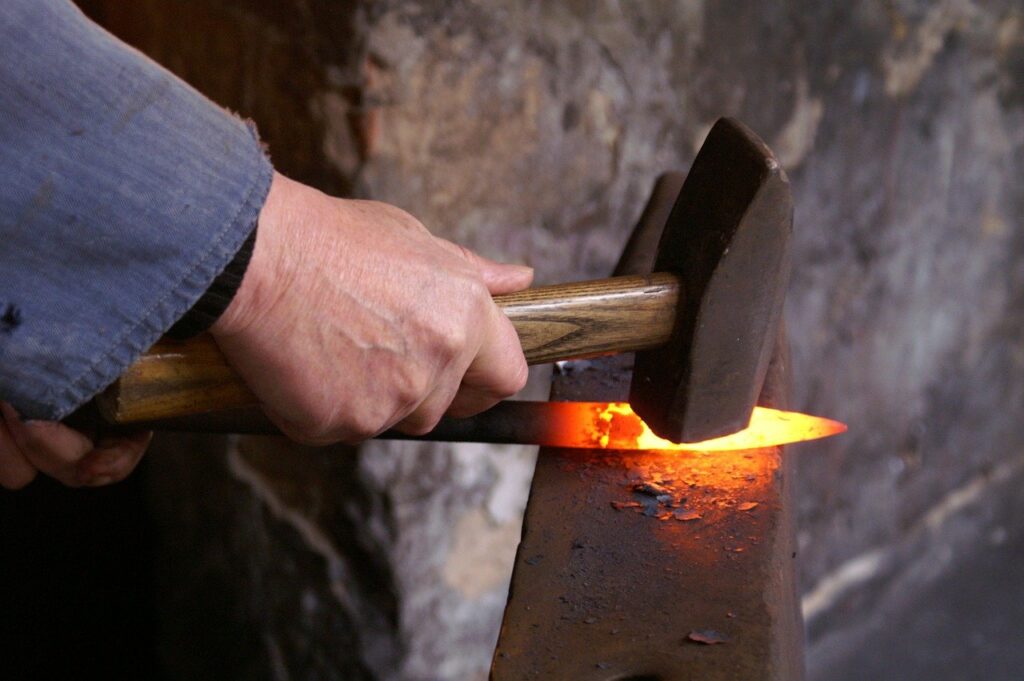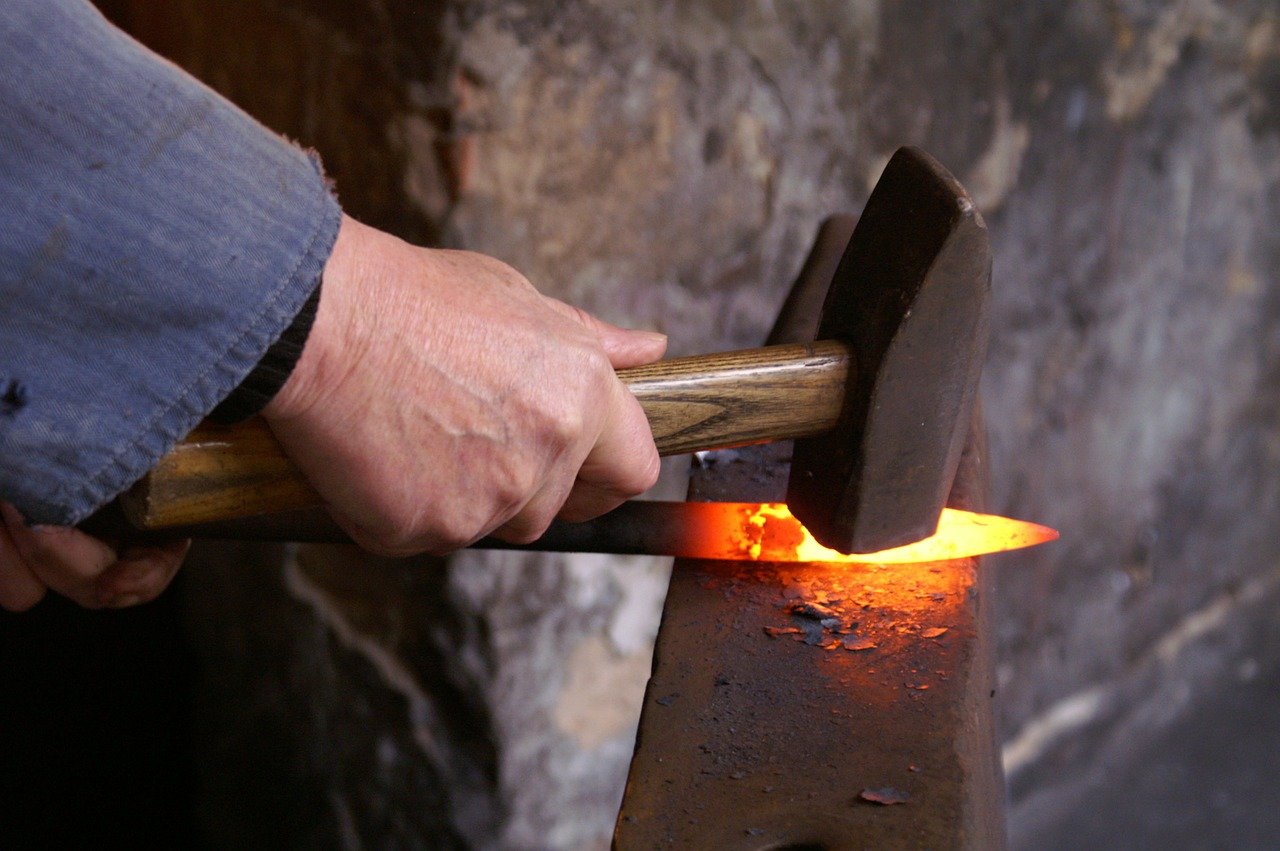
There are loads of excellent knife grinders available over in the USA, however here in the UK it can be very hard to find decent belt grinders for making knives.
What should the aspiring bladesmith do in the UK? Buy from the USA and risk hefty shipping costs and, potentially, import fees? What about returns?
Or should you buy a kit & make your own? Risky, considering the speed that the belts turn, and the fact you’ll likely be grinding hard steel!
To get started, what type of grinder is the BEST for bladesmithing? Let’s get that covered-off…
… then we’ll soon update this website with where you can buy excellent belt grinders for knife making here in the UK!
Factors to Take into Account Other Than Belt Size
Irrespective of if you create knives for a living or just for fun, having access to the correct belt grinder can make all the difference when it comes to producing a beautiful, clean blade. There are a variety of machines available, some of which are better suited to specific knife-making processes than others. We’ll look at the benefits, drawbacks, and recommended uses of some of the most popular belt grinder sizes for knife production in this article.
KNIFE GRINDERS 2X72
Standard belts of 2 inch width (and 72 inch long) are used in the industry for creating professional-quality knives. The bulk of belt grinding machines used in the knife industry in North America are this size. For the level of performance, the units are surprisingly small and can work with a wide variety of belt materials. In addition, there are more accessories available for 2×72 belt grinders, including:
knife aspects like fullering, hollow grinding, and more may be done with wheel attachments that range from 1/4″ to 16″.
Surface grinding attachments are used for cleaning and smoothing down rough edges on flat surfaces.
Convex grinds and the dreaded “J weight belt bump” can both be mitigated with rotary platens.
As a result, you can use the 72-inch belt during all stages of blade manufacturing, from initial knife development stages to finishing touches like honing and polishing, without having to replace it. A 2×72 can manufacture knives faster than a smaller belt grinder since it has a wider work area and a variable speed motor.
The price of 2×72 belt grinders is by far its largest drawback. They’re an excellent investment for experienced knife manufacturers, but if you’re a hobbyist or just getting started, a 2×42 grinder would be a better choice in the beginning.
A knife maker’s abrasives package for 2×72 belt grinders is available from Red Label Abrasives. Various ceramic grits are available, including premium coarse grits for longer belt life, Edgecore grits for better grinding outcomes, and ultra-fine grits for ultimate sharpening and polishing.
That which is the best 2 X 72 inch grinder for US? Visit the Brodbeck Ironworks website for further information.
KNIFE GRINDERS 1X30
For enthusiasts, a 1×30 belt grinder is a wonderful finishing tool because it’s an inexpensive investment. But the 1″ belt is not wide enough to adequately smooth off material on bigger knives (although some grinders contain a 6″ disc sander that assists with this stage). They are good for knife sharpening and detail work. It has a smaller abrasive surface area, thus it won’t be as effective at mitigating heat, and the belts may need to be replaced more frequently. Thick materials like surface conditioning belts might be difficult to run due to the limited power and clearance.
In order to get the most out of your 1×30, you’ll want to utilise a high-quality abrasive compound. There are a variety of grits available from Red Label Abrasives, including coarse, medium, and fine, giving you a variety of options for honing, sharpening, and polishing your blades.
KNIFE GRINDERS 1X42
The performance of 1×42 belt grinders is comparable to that of 1×30 grinders. The grinding surface area is slightly larger, and the machines are more reasonably priced. A lot of professional knife makers keep both 2×72 and 1×42 grinders on hand in their work spaces.
Detail work and knife sharpening benefit from the use of 1×42 belts. Belt grinders with a smaller work surface and lower motor power are better suited to creating knives more quickly than those with larger work surfaces and more motor power, such as the 2×72 grinders.
A 2×42 belt grinder is usually preferable to a 1×42 belt grinder. Because of the bigger belt, the 2×42 grinders are more stable, and they’re also cheaper.
KNIFE GRINDERS 2×42
For the woodworking sector, 2×42 grinders commonly have a 6″ disc sander on the side. They are still popular with amateur knife makers who are just starting out and need an entry-level grinder since they work well for manufacturing knives. The 1×30 and 1×42 belts are less stable than the 2×42 belts. With the 6″ disc, simple operations like beveling the front of knife scales can be accomplished quickly.
The 1/3hp motor is the major drawback of 2×42 grinders. As you grind, the slower motor will slow down, reducing your grinding capacity.
KNIFE GRINDERS 2X48
2×48 grinders are a good substitute for 2×72 grinders because they are smaller. People in many walks of life utilise them. Some small grinding machines, such the 2×48 belt grinders, have a more powerful motor. Grinder prices start at around $330, making them accessible to a wide range of people.

- Readers Rating
- No Rating Yet!
- Your Rating
There are loads of excellent knife grinders available over in the USA, however here in the UK it can be very hard to find decent belt grinders for making knives.